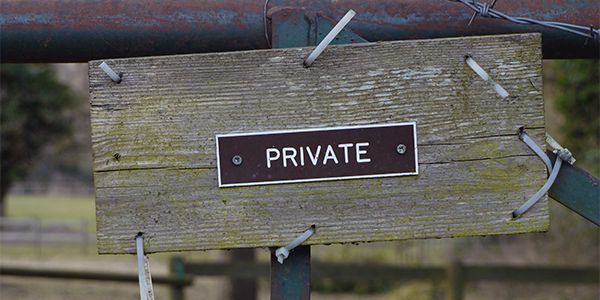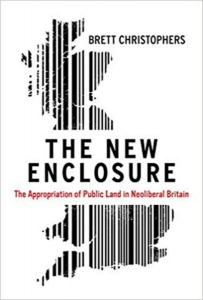Book Review | The New Enclosure: The Appropriation of Public Land in Neoliberal Britain by Brett Christophers
In The New Enclosure: The Appropriation of Public Land in Neoliberal Britain, Brett Christophers offers a forensic analysis of Britain’s biggest and most consequential privatisation: the privatisation of land. This is a crisp, nuanced text that contributes to our understanding of recent economic transformations and provides a distinctive account of neoliberalism. A must-read, writes John Tomaney.

Picture: (Tristan Ferne CC BY 2.0)
The New Enclosure: The Appropriation of Public Land in Neoliberal Britain. Brett Christophers. Verso. 2018.

In The New Enclosure: The Appropriation of Public Land in Neoliberal Britain, Brett Christophers claims that Britain’s biggest and most consequential privatisation is its least known and understood. The Margaret Thatcher-era privatisation of state-owned industries and utilities and sell-off of council houses are well documented in the academic literature, but it is the privatisation of land that lies at the heart of these disposals and its results have been profound.
The New Enclosure fills a gaping hole in our understanding of the contemporary history of British capitalism. It offers a forensic analysis of the privatisation of British land, contributes to our understanding of recent economic transformations and provides a distinctive account of neoliberalism.
The book’s title evokes an earlier moment of capitalist development when, in the late eighteenth century and early nineteenth century, land previously held in common was enclosed and commodified. The current period signifies a new enclosure. Christophers views the present episode through the lens of neoliberalism which he defines, unconventionally, not as the extension of market mechanisms but as the transfer of publicly owned assets to private ownership.
The ownership of land matters because it expresses political influence and power and is a source of income and wealth. (It also has aesthetic and spiritual affects – according to Alexander Pope, ‘Happy the man whose wish and care/A few paternal acres bound,/Content to breathe his native air/In his own ground.’) The economic importance of land is accentuated by its role as collateral: it is a store of wealth. Its privatisation deepens inequality and foments economic disorder because it inheres monopoly and speculation, induces social dislocation and constrains development opportunities to a narrow calculus of private returns. Ownership of land (and buildings) now forms the largest component of wealth in the UK.
The classical economists understood the special characteristics of commodified land. Land market failure is endemic because of the multiple and complex externalities that arise from its exclusive use. According to John Stuart Mill, land afforded an ‘unearned increment’ – its value can rise through no effort or enterprise on the part of the owner. During the nineteenth century, concentrated land ownership came to be regarded as immoral, unjust and inefficient, offering unwarranted returns to owners.
The early twentieth century saw the expansion of public land ownership often resulting from the ambitions of local government to provide housing, infrastructure and services. This process accelerated as a result of the strategic exigencies of World War Two. The Clement Attlee government extended state control further, notably by enacting the Town and Country Planning Act 1947, creating New Towns and introducing ‘betterment’ levies designed to capture for the taxpayer some of the unearned increases in land values arising from government action. Nationalisation of key industries such as coal, railways and water brought more land under state control. Christophers sees the expansion of public ownership as a response to the excesses of nineteenth-century rentier capitalism and as an instance of Karl Polanyi’s ‘double movement’.
From the outset, an ideological counterattack was launched against public land ownership, gaining momentum in the 1960s and 1970s. A dubious discourse identified the problem of ‘surplus’ public land and the supposed ‘efficiency’ of private ownership. Both claims, as Christophers demonstrates, are simultaneously unfounded and politically powerful, providing cover for the massive programme of privatisation under the Thatcher and John Major (1979–1997) and Coalition (2010–2015) governments. A long, slow and piecemeal process included, among other things, the sale of council houses, school playing fields and estate owned by the NHS, the (now privatised) Forestry Commission and the Ministry of Defence. The privatisation of state-owned enterprises such as the National Coal Board, British Rail and Water Authorities centrally concerned the transfer of land to private owners. (Devolution has placed some geographical limitations on this process: water remains in public ownership in Scotland and the right to buy has been ended there and in Wales.)
The extent and nature of land privatisation have been poorly recorded. Christophers carefully estimates that an astonishing 2 million hectares of public land, worth £400 billion, has been appropriated by the private sector in recent decades, representing 10% of the British land mass. As he observes, scarcely any social obligations – such as the provision of affordable housing – were placed on those who acquired the land. No effort was made officially to assess the social and economic impacts of this transformation, but there have been many unintended social consequences. The Right to Buy stands out and is well-documented. Intended to herald a new ‘property-owning democracy’, many former council houses are now in the hands of private landlords, some councils are now renting houses they previously owned, while the rate of home ownership is falling, especially among the young.
As Christophers observes, echoing the arguments of Josh Ryan-Collins et al, the new enclosure has accompanied the emergence of ‘financialised landownership’ (112) in which insurance companies, banks and pensions funds regard real estate as a financial asset rather than a site for productive activities or the provision of affordable homes. He notes that income from property is now the biggest single contributor to UK economic growth and wonders, reasonably, about the sustainability of this. Privatisation of land has contributed crucially to rising inequality. Yet the circus continues: cash-strapped local authorities are speculating in commercial property in order to fund public services, while a handful of large developers hold extensive undeveloped land banks for which they have been given planning permission. The planning system represents a convenient scapegoat, but it cannot be held culpable for the regressive outcomes charted in the analysis.
Christophers muses on why the privatisation of land has garnered so little attention or opposition given its regressive outcomes. He attributes this partly to public scepticism about the value of collective ownership and partly as a result of polices such as the sale of council houses, which means many on modest incomes are implicated in privatisation and reliant on appreciating property values to maintain their standard of living. (Colin Crouch terms the latter ‘Privatised Keynesianism’.) Here lies the key political challenge facing the advocates of change – where is today’s coalition in favour of land reform?
Christophers has written a crisp but nuanced text, leavened with sardonic humour, alive to the complexity and opacity of his subject. A must-read.
This review and interview gives the views of the author, and not the position of Democratic Audit. It was first published by the LSE Review of Books blog.
John Tomaney is Professor of Urban and Regional Planning in the Bartlett School of Planning, University College London. Read more by John Tomaney.





 Democratic Audit's core funding is provided by the Joseph Rowntree Charitable Trust. Additional funding is provided by the London School of Economics.
Democratic Audit's core funding is provided by the Joseph Rowntree Charitable Trust. Additional funding is provided by the London School of Economics.